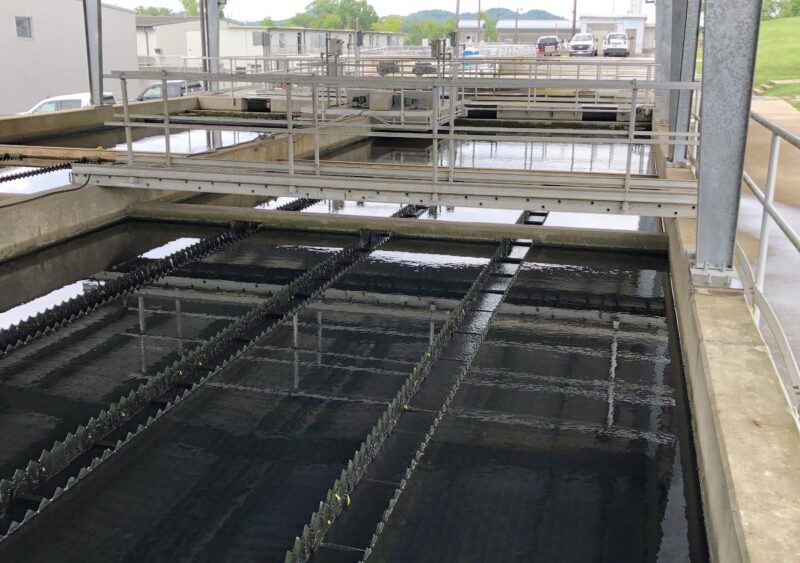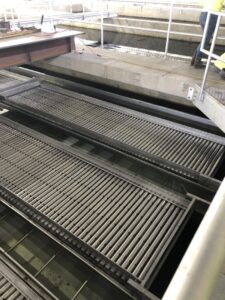
Five Design Considerations for Plate Settlers in Water Treatment Plants
 In recent years, SSR has retrofitted tube settler installations with plate settlers and designed new plate settlers for several local municipalities in the region. Utilities’ recent increase in interest of plates over tubes has primarily been charged to the need to increase settled water production without significant infrastructure changes. Compared to traditional settling and tubes, plates are more efficient in settling due to the plates’ tight spacing and inclined angle, increasing the effective settling area over a small footprint. Plate settling is eight times as effective as traditional settling and twice as effective as traditional tube settling. Our familiarity with the equipment design and installation details has enabled us to develop creative solutions to retrofits and greatly reduced unforeseen construction issues, allowing for a streamlined construction process and minimal downtime for individual basins. The following are five design considerations you should make when considering plates either as a retrofit or for a new basin.
In recent years, SSR has retrofitted tube settler installations with plate settlers and designed new plate settlers for several local municipalities in the region. Utilities’ recent increase in interest of plates over tubes has primarily been charged to the need to increase settled water production without significant infrastructure changes. Compared to traditional settling and tubes, plates are more efficient in settling due to the plates’ tight spacing and inclined angle, increasing the effective settling area over a small footprint. Plate settling is eight times as effective as traditional settling and twice as effective as traditional tube settling. Our familiarity with the equipment design and installation details has enabled us to develop creative solutions to retrofits and greatly reduced unforeseen construction issues, allowing for a streamlined construction process and minimal downtime for individual basins. The following are five design considerations you should make when considering plates either as a retrofit or for a new basin.
Structural
Unfortunately, the swap to plates from tubes is not as simple as demolition of tubes and installation of plates in their place. For one, tubes are highly flammable, and caution must be taken when removing them as to not cause a fire. Structural investigations for the heavier plate packs of the sedimentation basin remain a critical component to the design and retrofit process. Older sedimentation basins did not account for the heavier plate load, so walls may not be structurally sound to support the heavier plate packs. To remedy this, reinforcement of walls and the addition of support beams may be required under the plates. Modifications to the sedimentation basin’s weir may also be needed to incorporate the plates’ built-in weirs; however, sometimes existing troughs can be reused. Additionally, if installing plates in multiple basins that parallel each other and share common walls, it’s important to offset the plates’ support beams in adjacent basins as to prevent the anchors from potentially running into each other.
Hydraulics
In retrofit scenarios, most older sedimentation basins were originally designed for only the traditional sedimentation process without other aided technology like tubes or plates to assist in the increase of settling. As a result, old existing basins tend to exhibit hydraulic bottlenecks and constraints when attempting to increase process flows. While it is recognized that the plate settler distribution weirs will provide some flow distribution benefit, ultimately a design team will need to thoroughly examine the overall layout of the existing basins when laying out the retrofit to ensure an effective hydraulic design for effective flow balancing. Factors like detention time can be ignored in plate settler design, unlike traditional sedimentation, but things like cross-sectional velocity should still be considered to minimize the effect of shearing floc. When increasing the flow rate through sedimentation basins, it’s important to take into consideration the effect of increasing flow through the sedimentation in the upstream process like flocculation. Increasing flows through flocculation may be detrimental to the treatment process if velocities are increased such that shearing of floc occurs and detention times are not adequate to form a good floc.
Solids Removal
Because plates are more efficient than tubes and traditional sedimentation in terms of settling, you are likely to experience a higher concentration of solids below your plate pack. It is important to ensure your existing solids removal equipment can handle the higher concentration of solids loading. If not, upgrades may be needed. It’s also important to take into consideration the clearance depth below your plate pack and your solids collections system to ensure there are no conflicts there. Lastly, it’s important to consider the clearance between the plate pack and the solids blanket to ensure no disruption of the sludge blanket due to increased velocities.
Retrofit Flexibility
As previously mentioned, it’s possible to repurpose existing troughs of traditional sedimentation basins, clarifiers, or tube systems to incorporate the effluent from a plate system. Although a standard plate is 4.5’ x 9.5’, the standard plate size can be modified to account for shallower basins or narrower installations. A smaller plate width would result in an increase in the number of plates in a pack to make up for the loss in surface area. However, a longer plate pack means a greater potential for scouring the sludge blanket at the bottom of existing basins, as well as potential physical conflicts with the existing sludge collectors. The smaller plates also mean more plates will need to be added to the basin to meet the required surface area for sufficient settling purposes, which means larger, and more support beams may be needed. Assuming the basin itself is structurally sound as well, cantilevering the plate packs is also a potential in some circular clarifier situations.
Cost and Timing
Over the past two years, the cost of stainless steel has increased over 80 percent. Over the last few months, prices have come down but remain 50 percent higher than they were two years ago. Due to the volatility of the global market, it’s important to consider the price in your budgeting process, given that plates can only be made of stainless steel. Lastly, most plate retrofits happen during winter months when flows are reduced through plants and demand is lower, allowing operational flexibility to take a basin offline. Because of this, it is typical to see longer lead times in winter months from manufacturers as every utility wanting to install plates tends to do it at the same time. If you have the flexibility in terms of basin capacity, it may be best to install your plates in the summer to avoid longer lead times. If time is an issue in getting your retrofit completed, it’s important to plan ahead and have your project designed and bid with adequate time to account for the lead times.
Our recent, extensive experience with this technology has been successful due to our great working relationships with local reps and equipment manufacturers. We are excited to use these strong connections to help you in your next retrofit, upgrade, or new design.








